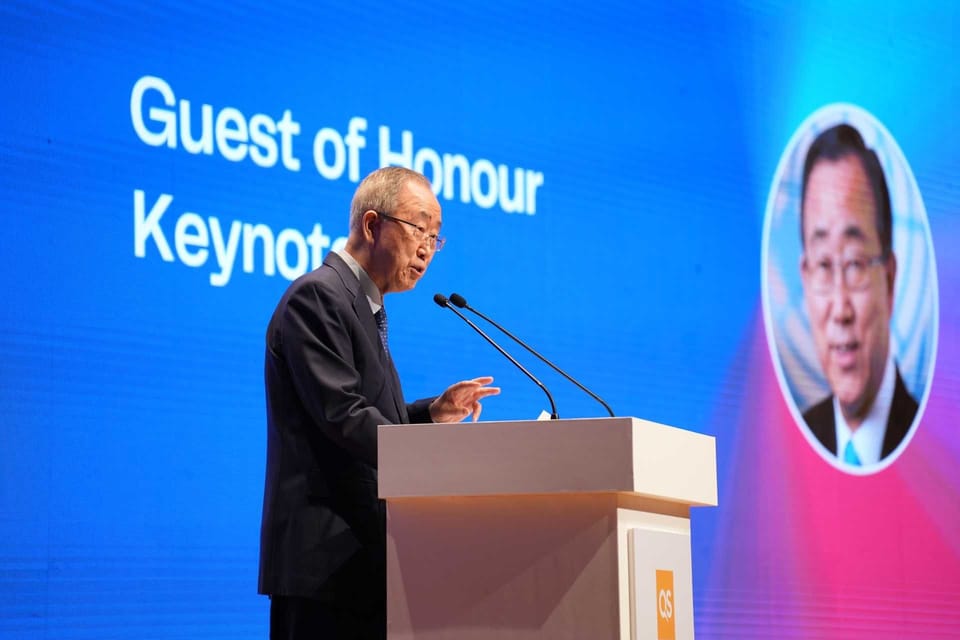What might the future of university mergers look like?
QS MidWeek Brief - October 22, 2025. Are there additional reasons for uni mergers, other than to avoid closure? And why are more students choosing a Chinese business education?

Welcome! “Merger” has become the word de jour in recent history. Facing a number of different challenges, and staring down a substantially worse outcome, closure, it makes sense that universities might want to combine their strengths. But the decision to merge isn’t always about improving finances or avoiding the worst, there are plenty of other reasons to do it.
This week, we explore those reasons in depth to discover the history of mergers goes back much further than we might realise. We also travel to China to learn more about the benefits of its business education.
Stay insightful,
Anton John Crace
Editor-in-Chief, QS Insights Magazine
QS Quacquarelli Symonds
Mega, Super, Better
By Viggo Stacey

In Brief
- Higher education institutions worldwide are embracing mergers, from Australia to Korea, to boost global competitiveness, scientific strength, and financial viability in an increasingly oversaturated buyer's market.
- While mergers offer a path to stability amid dwindling public funds, experts debate if they are true collaborations or defensive takeovers focused primarily on stripping costs and downsizing.
- To succeed, institutional leaders must look beyond cost reduction and use consolidation as an opportunity to widen capabilities, protect jobs, and build solid financial foundations for the future.
The newly formed Adelaide University in South Australia is expected to contribute $4.7 billion to the Australian economy annually. Similarly, a new ‘super-university’ in the UK between University of Greenwich and the University of Kent is expected to “combine the strengths” of each institution.
Each will retain its name and identity, student bodies will increase and London and the South East of England will have “a powerful force”, leaders say.
Over in Kyrgyzstan, an announcement in early September stated that merging three institutions into the Kyrgyz National University would strengthen financial, human and scientific potential and enhance their competitiveness in the global education market.
In Korea, Changwon National University will merge with University of Gyeongnam Geochang and University of Gyeongnam Namhae to form a new institution from March 2026.
In a landscape where institutions are increasingly competing for motivated international students, talented researchers and academia burdened to maintain a competitive edge, institutional leaders are under pressure to stay ahead of the pack.
One easy assumption could be that more students mean more advocates, more impact, more funding, more research. Being part of a larger institution might also reduce the risk in what is increasingly seen as an oversaturated buyer’s market.
Talk to many in the sector now, they will tell you about the need for higher education to recalibrate, consolidate and strengthen collaboratively in order to build a stable foundation from which to grow.
Merging through time
Long before the frenzy of Adelaide’s new mega-university, Australia saw the Dawkins Revolution. A 1988 policy statement, published when John Dawkins was Education Minister, noted that universities could attract more industry support and involvement in research, offer students access to a wider range of study options and create savings by merging with Colleges of Advanced Education.
Consolidation “does not necessarily mean an amalgamation or total absorption of a smaller institution into a larger one”, it said. Affiliation or association to protect special institutional features are some of the “various arrangements [that] are possible”. But it concluded, a full amalgamation or merger “should be the preferred solution in most circumstances”.
Fast forward almost four decades to today and this policy could be one published by governments across the globe.
In Canada, provincial governments are said to be encouraging institutions to look at all sorts of tie-ups. The UK – which is about to see the release of its higher education whitepaper – already has the UUK’s Transformation and Efficiency Taskforce, giving an “all options on the table” approach to how UK institutions can partner and collaborate new models and ways of working.
New Zealand has experimented by merging all its polytechnics into one provider, Te Pukenga, only to be de-merged by the next government. The US, with its powerful private institutions, has seen at least 39 public and private mergers since March 2020, according to one analyst.
A stakeholder based in the US tells QS Insights Magazine, that consolidation is “the next big thing”, and something that has been in the making for the last three decades.
“It’s something that you hear about, but it never quite seems to happen. Generally, it’s usually an acquisition or an absorption rather than an arrangement of equals,” they say. “If you ask me, I think consolidation is long overdue and can be done in ways that preserve individual institutional identities.”
This is exactly what Greenwich and Kent in the UK will hope their ‘super-university’ will achieve.
The plan, announced in September, was promoted as a blueprint for other institutions to follow, with the London and South East University Group promising to be "resilient and financially viable" at a time of heightened financial challenges in the UK. Importantly, each institution will retain its brand, identity and local presence.
Others reframed the announcement as a takeover, not least of all University and College Union general secretary Jo Grady, who writes in a response article that leaders had failed to present a “clear and coherent strategy for how it will deal with the crisis in higher education”.
She emphasizes that university workers were feeling “overlooked, overworked, ignored, and undervalued”, calling for reassurances that jobs and student provision would be protected. This is one challenge for any university leaders to deal with.
But, what are the alternatives? A previous edition of QS Insights Magazine (issue 31, July 2025) warned that in 2024, at least 14 UK universities were ‘implementing redundancy programmes affecting arts degrees or closing creative courses’. Could mergers be a way to save some courses?
For many that QS Insights Magazine spoke with, much is yet to be seen and while mergers have the potential to deliver better quality, there is no guarantee.
“It takes a lot of internal naval gazing, machinations and disquiet to get to that point [of delivering better quality, lower cost and improved service],” according to one source.
When Victoria College merged with Deakin University in 1991, the Victoria name all but disappeared but there was still a question of merging cultures. One stakeholder who worked at the merged institution a decade later tells QS Insights Magazine that there was still some residual grumbling about the merger then, but that largely it’s now safe to say that the merger was successful.
How to succeed
Whether a merger succeeds depends a lot on why it is taking place, the circumstances and how the heavily bureaucratic institutions can come together effectively.
“Mergers driven by the need to cut costs will inevitably harm learners, researchers and society,” higher education expert, Nigel Healey, tells QS Insights Magazine.
“Forty years ago, mergers were seen as a way of building large comprehensive universities from smaller, discipline-specific institutions to meet the growing demand for higher education.
“Today, mergers are seen as a defensive strategy to strip out cost and downsize institutions to preserve their financial viability. The contrast between then and now could not be starker.”
Similar to provincial Canada, the state government in Western Australia has established a committee to undertake the cost-benefit analysis of university mergers, with indications that authorities could prefer two universities instead of the current four.
During a 2023 review in the state, University of Western Australia (UWA) suggested cross-sectoral mergers between universities and vocational education providers (VET) could “create a seamless transition through education pathways for domestic students”. Additionally, such mergers might widen access, promote opportunities for university students to participate in government-run VET providers, TAFE, and enhance pathways into the workforce.
However, UWA questioned whether a merged model could result in overall higher dollar funding than two institutions individually, and warned of a loss of top researchers and reputational damage. It also cautioned of PhD pipeline disruptions, as prospective international PhD students could choose to avoid institutional uncertainty.
“No existing two-institution merger would clearly provide a competitive advantage in research capacity that could not be achieved through other models such as research joint ventures or federation,” the institution noted.
And further evidence around benefits is somewhat limited. One 2018 research paper from the University of Huddersfield found that the efficiency of merged higher education institutions is around five percentage points higher post-merger than non-merging HEIs. However, the efficiency benefit does not last more than a year after the merger takes place, researchers found.
Others QS Insights Magazine spoke to emphasised the challenge of generalising about mergers.
“If government funding of HE continues to dwindle, then I think mergers become a necessary evil,” one commentator says. “I suppose the challenge is then in creating large institutions that lose their connection with local communities.
An experienced communications professional, Viggo joined QS as PR Specialist in late 2024. As a former journalist, he seeks to gain traction in the press for the organisation’s sector-leading data and insights, drive thought leadership strategy and manage the reputation of the company. He is passionate about personal stories and the impact of international education on individuals across the globe.
China as a Global Gateway for Business Education
By Niamh Ollerton

In Brief
- Once primarily for domestic students, top Chinese business schools are now attracting international talent worldwide, acting as vital bridges between East and West post-COVID.
- Schools embed students in Chinese culture and innovation ecosystems, not just instruction, offering first-hand exposure. Curricula integrate AI management and hard-bake ESG principles, ensuring graduates gain critical skills and globally recognised qualifications.
- Schools leverage international faculty and innovative joint ventures to compete globally. They focus on sustainable transformation, innovation, and cross-cultural agility.
China’s role in global business has never been more complex, or more compelling.
For many years, even decades, China was seen as a destination for ambitious domestic students, but the tides have turned.
Today, Chinese business schools are attracting talent from every corner of the globe, positioning themselves as bridges between East and West.
But schools are doing this in more ways than offering English-taught degrees.
Institutions are immersing students in China’s rich culture and heritage, offering an introduction to China’s fast-moving economy, providing direct access to the country’s vast innovation ecosystem, while also connecting them to international networks, faculty and career opportunities.
Universities and business schools elsewhere are also looking at China as a hub for cutting-edge research, industry partnerships and cross-border leadership training.
“We’re not just training students to work in China,” says Thomas Durham, International Public Relations and Branding Manager at International Business School Suzhou (IBSS), “We’re equipping them to connect China to the world, and the world back to China.”
Chinese business schools are transforming into international gateways, where students gain first-hand exposure to the country’s innovation ecosystem while earning globally recognised qualifications. Studying there is becoming a strategic advantage for students and the companies that will employ them in the future.
Rebuilding global flows
The post-COVID reset has seen a resurgence in China’s standing as a study destination.
Professor Kok Wei Khong, Dean of Nottingham University Business School (NUBS) China tells QS Insights Magazine that his institution is seeing a shift in behaviour following post-COVID and geopolitical changes.
“Students in Europe are returning to China as exchange students, while there is a good influx of students coming from ASEAN. Our business school is thriving with the influx of international students.”
Professor Majid Ghorbani, Deputy Director of Global MiM China Europe International Business School (CEIBS) (Switzerland)-ESCP Double Degree Programme also notes a similar surge of international students on CEIBS programmes.
He tells QS Insights Magazine, “In some of our programmes, the proportion of international students exceeds 40 percent, ranging from Eastern and Western Europe, various countries in Africa and Latin America, as well as numerous Asian countries.”
Durham agrees with the sentiment, adding that the appetite among international students to study in China, and specifically at IBSS (the largest English-language business school in China), continues to grow.
“Many are motivated by the opportunity to immerse themselves in the richness of Chinese culture while benefiting from a fully English-taught curriculum and dual degree option that opens doors globally.
“They are pragmatic too (and increasingly discerning!) seeking value for money, exposure to China’s dynamic innovation ecosystem and career opportunities in one of the world’s fastest-growing markets.”
Student experience in China
Immersion, not just instruction, is what sets high-ranking schools in China apart; they don’t only teach about China,- they embed students in the culture.
Professor Ghorbani says CEIBS helps international students with cultural career integration, and that by starting their studies in the vibrant, international metropolitan city that is Shanghai, students experience a soft introduction to China.
“We offer Chinese classes and tutoring to all full-time students who need it; we have many clubs and cultural activities that familiarise international students with life and work culture in China,” he says.
Offering both cultural and educational trips to cities enables students to get a feel for what working and living in different cities across China is truly like, Professor Ghorbani notes.
“For our MBAs and future master’s students, we sharpen their skills and talents and help them refine their career goals. Our Innovation Lab [formerly eLab] helps anyone interested in starting a venture to get help through all stages of startup.
“Through mentorship, internship, consultancy projects, company visits, executive seminars and working with our extensive alumni network, our students get hand-picked for key positions,” he adds.
IBSS’s model is similarly experiential.
Durham says students are offered a myriad of opportunities like consulting with companies in Suzhou Industrial Park, earning Bloomberg certifications on the Trading Floor, and accessing networks such as QTEM, which links them to top institutions worldwide.
“In short, they gain global perspectives while experiencing business in China first-hand,” he adds.
Niamh Ollerton is a Press Association NCTJ trained journalist and has been a writer, content creator and editor for 10 years for organisations within Higher Education, startups and scaleups and tech industry spaces including QS, Tech Nation and MSN. A storyteller by trade and a people person by nature, Niamh enjoys learning about the inner workings of businesses and what makes the people who run and grow them tick - bringing their stories to life both online and in print.




